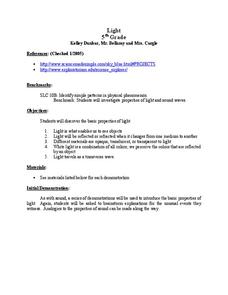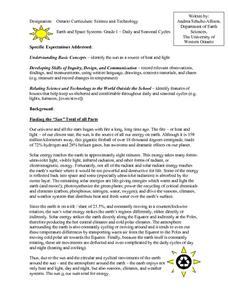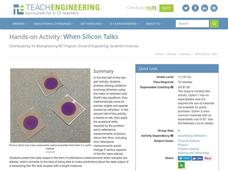Curated OER
Light
Fifth graders sit in their seats with the lights on and then the teacher turns off the lights. After their eyes have adjusted, they vote on what colors of construction paper are being held up. The lights are then turned back on and...
Curated OER
Art as a Reflection of Society
Students write about their interpretations of "Glow of the City," discuss "Glow of the City" in terms of imagery, symbolism, use of shadows and light, and ways that it reflects life in the late 1920s in New York.
Curated OER
Reflection Experiments
Seventh graders investigate with light rays. In this light instructional activity, 7th graders determine the angle of reflection using simple materials. They continue the investigation by exploring the theory that light which is not...
Curated OER
The Science of Color and Light
Students listen to a story about colors and then conduct various experiments to determine how people see colors, identify which colors stand out best from a distance, show the results of mixed colored lighting and explain the phenomenon...
Exploratorium
Parabolas
A parabolic mirror toy demonstrates how concave mirrors objects reflect light and produce a realistic image at their focal point. This resource probably doesn't explain any more than the printed insert that accompanies such an apparatus...
Curated OER
Noncombatancy and the Seventh day Adventist Church
Upper graders investigate how the Seventh Day Adventists are objectors to the practice of war. The lesson covers the Civil War and examines the church's position about the practice of war. The research extends to modern wars and learners...
Curated OER
Miscellaneous Light Topics
In this light topics science worksheet, students read selections about fiber optics, fluorescent light, incandescent light, total internal reflection, polarization, glow-in-the-dark light, and lasers. Students then respond to 32...
Curated OER
Reflection and Absorption of Light
Students use a microcomputer connected to a light sensor and temperature probe to explore the reflection and absorption of radiation for different surfaces. Students follow instructions in this guided inquiry based lab and are then asked...
Curated OER
Light My Fire!
High schoolers draw a diagram that shows the law of reflection. In this physics lesson, students investigate the relationship between the angle of incidence and angle of reflection. They explain how light travels as it reflects on a...
Curated OER
Reflection & Refraction
In this online interactive reflection and refraction worksheet, students respond to 7 multiple choice and fill in the blank questions regarding the information included in the provided paragraphs.
Curated OER
Light
Students observe how light can be reflected, refracted, and absorbed. In this light lesson, students discover that light travels in a straight path. This lesson contains a "bonus" activity that explains how to make a kaleidoscope.
Curated OER
Light Is Amazing
Young scholars investigate light and its energy. They discuss the properties of light, research how much light the moon absorbed on their birthday on a website, complete a graphic organizer, and create a kaleidoscope.
Curated OER
Kaleidoscope
Students explore energy by creating a light project in class. In this kaleidoscope lesson, students discuss the properties of light and how mirrors can reflect the energy in different directions. Students view a diagram of light...
Curated OER
I'm So Bright, I Wear My Shades Indoors
Students observe and draw energy using UV beads. They describe how light can be produced, reflected, refracted, and separated into visible light of various colors.
Curated OER
Daily and Seasonal Cycles
First graders identify the sun as a source of heat and light. They identify features of houses that help keep use sheltered and comfortable throughout daily and seasonal cycles. Students are told that summer is the best season to...
Curated OER
Elementary Exploration: Seeing the Light
Students use critical thinking skills to learn about light, sound, and matter. Students follow the procedure steps to complete a light, sound, and matter experiment.
Urbana School District
Optics
Don't worry, optics is a light topic! The presentation covers reflection, refraction, fiber optics, mirages, prisms, rainbows, dispersion, mirrors, lenses, telescopes, diffraction, the human eye, and much, much more. Presentation is the...
Exploratorium
Touch the Spring
Concave mirrors and the images they produce are traditional topics in the physics classroom. This resource explains how to set up an investigation of them, and it provides you with the explanation of concepts.
Discovery Education
Through the Looking Glass
Turning white light into colors only takes a little scientific know how! Young scholars create their own spectroscope in a hands-on activity exploring the properties of light. Using a diffraction grating, they discover how white light...
National Nanotechnology Infrastructure Network
Jell-O® Waveguide and Power Loss
Jell-O® can help model the transmission of light through fiber optic cables. Young scientists use the jiggly dessert to make a waveguide to transmit a laser beam from one point to another. Their models help them learn the function of...
Teaching Tolerance
Reflection: What’s Your FRAME?
Encourage your class to recognize the diversity in the beliefs and backgrounds of their peers. Learners use the acronym FRAME to consider culture, background, and life experiences.
CK-12 Foundation
Diamond Cut
How do jewelers tell the difference between diamonds, glass, and cubic zirconia? A sparkling simulation demonstrates how to use a ray of light to determine the substance and ideal shape for a diamond. Scholars control the material,...
American Institute of Physics
The Black Scientific Renaissance of the 1970s-90s: African American Scientists at Bell Laboratories
A two-part lesson asks young scientists to research the contributions of African American scientists at Bell Laboratories. After presenting their findings, class members watch two demonstrations that introduce them to total internal...
Teach Engineering
When Silicon Talks
Explore Snell's Law using thin films. In the fifth installment of a seven-part series, pupils solve a set of problems relating to Snell's Law and use this skill during an experiment requiring the collection of reflective measurements...
Other popular searches
- Light Reflection
- Light Reflection Refraction
- Light Reflection Mirrors
- Light Reflection by Mirror
- Science Light Reflection
- Light Angle of Reflection
- Light Reflection and Color
- Light Reflection and Mirrors
- Light Reflection Projects
- Light and Reflection
- Light Reflection Internet
- Reflection of Light Waves

























